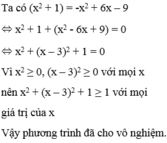
Hãy nhập câu hỏi của bạn vào đây, nếu là tài khoản VIP, bạn sẽ được ưu tiên trả lời.


a. \(\dfrac{x^2+2x+3}{x^2-x+1}=0\) ⇔x2+2x+3=0 ⇔x2+2x+1+2=0 ⇔(x+1)2+2=0
Vì (x+1)2+2>0 nên phương trình đã cho vô nghiệm.
b) \(\dfrac{x}{x+2}+\dfrac{4}{x-2}=\dfrac{4}{x^2-4}\) ⇔\(\dfrac{x\left(x-2\right)+4\left(x+2\right)}{\left(x-2\right)\left(x+2\right)}=\dfrac{4}{\left(x-2\right)\left(x+2\right)}\)
⇔\(x\left(x-2\right)+4\left(x+2\right)=4\) ⇔x2-2x+4x+8-4=0 ⇔x2+2x+4=0 ⇔x2+2x+1+3=0 ⇔(x+1)2+3=0
Vì (x+1)2+3>0 nên phương trình đã cho vô nghiệm.


Đặt \(B=x^2+x+3=0\)
\(\Rightarrow2B=2x^2+2x+3=0\)
\(\Leftrightarrow x^2+\left(x^2+2x+1\right)+2=0\)
\(\Leftrightarrow x^2+\left(x+2\right)^2+2=0\)
\(\Leftrightarrow x^2+\left(x+2\right)^2=-2\)
Có : \(x^2\ge0\)
\(\left(x+2\right)^2\ge0\)
\(\Rightarrow x^2+\left(x+2\right)^2\ge0\)
Mà \(-2< 0\)
Vậy pt vô nghiệm .
Cách 1. \(x^2+x+3=\left(x^2+x+\frac{1}{4}\right)+\frac{11}{4}=\left(x+\frac{1}{2}\right)^2+\frac{11}{4}>0\)
Dấu "=" không xảy ra nên pt vô nghiệm.
Cách 2. Ta có \(x^2+x+3=\left(x^2+x+1\right)+2\)
Mà \(x^2+x+1\) là bình phương thiếu của một tổng nên vô nghiệm.
=> PT vô nghiệm.

Đặt \(B=x^2+x+3=0\)
\(\Rightarrow2B=2x^2+2x+3=0\)
\(=x^2+\left(x^2+2x+1\right)+2=0\)
\(=x^2+\left(x+2\right)^2+2=0\)
\(\Rightarrow x^2+\left(x+2\right)^2=-2\)
Có:
\(x^2\ge0\)
\(\left(x+2\right)^2\ge0\)
\(\Rightarrow x^2+\left(x+2\right)^2\ge0\)
Mà \(-2< 0\)
Vì vậy phương trình vô nghiệm.

Ta có: 2(x + 1) = 3 + 2x ⇔ 2x + 2 = 3 + 2x ⇔ 0x = 1
Vậy phương trình vô nghiệm.
